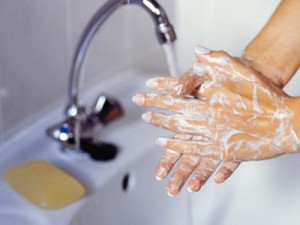Wash Your Hands? You May Now Approach the Patient Bed
Each year patients in the U.S. get more than a million infections while in the hospital being treated for something else. The best way to prevent infection is to practice proper hand hygiene, according to the U.S. Centers for Disease Control and Prevention.
At the University of Illinois Medical Center at Chicago, when a caregiver enters a patient’s room in an intensive care unit, a new, fully automated system will sense whether he has cleaned his hands. UIC is the fourth hospital in the country to install Xhale Innovations’ HyGreen Hand Hygiene System.
With the new system, after a health-care worker washes her hands with soap or gel, a sensor in the hallway or patient room sends a wireless “all clean” message to a badge worn by the caregiver. A wireless monitor above the bed searches for the message as she approaches. Absent the signal, the badge vibrates, reminding the wearer to wash. All interactions are recorded in a real-time database.
In 2009, Dr. James Cook, chief of infectious diseases at UIC, and one of his fellows, Dr. Hidetaka Kitazono, began searching for an automated way to improve hand hygiene that would not rely on observers stationed outside of patient rooms to track who washed and who didn’t.
“Behavior is hard to change,” says Cook, “but we want to provide the best care possible and provide patients with the latest hand hygiene system. This system gives us a way to monitor hand hygiene which is at the crux of all infection control prevention. It’s something that very few hospitals have.”
 In Chicago, only UIC and the Jesse Brown VA have installed this system in their ICUs, Cook said.
In Chicago, only UIC and the Jesse Brown VA have installed this system in their ICUs, Cook said.
Cook and his colleagues chose the HyGreen system because of its “innovative, yet unobtrusive” real-time feedback and database monitoring. Twenty-two patient rooms in the hospital’s neurosurgical and medical-surgical intensive care units have been equipped.
“We want to help remind people that they should use hand hygiene, and we want better data to monitor this critical activity,” said Cook, who notes that hand-hygiene adherence rates range widely, from 30 percent to 70 percent in some studies, and often the data are not very accurate.
Many different groups of caregivers - nurses, respiratory therapists, medical technicians, and physicians - will wear the reminder/monitoring badges.
 “We want to obtain a random sample of caregivers who have the most interaction with patients to look at their social behaviors, their acceptance of the system, and to monitor infection control rates,” said Cook.
“We want to obtain a random sample of caregivers who have the most interaction with patients to look at their social behaviors, their acceptance of the system, and to monitor infection control rates,” said Cook.
For more information about University of Illinois Medical Center, visit http://www.uillinoismedcenter.org
###
Source: University of Illinois at Chicago